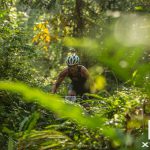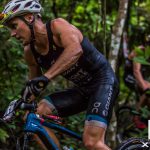XTERRA Asia Pacific Championships, Malaysia
Written by Will Kelsay June 21, 2017
To bring about change, sometimes you need to make a statement. A bold and attention worthy statement, not only in words, but in actions. Think of Katniss and Peeta in the finale of The Hunger Games. In front of all watching, they agreed to eat the fatally poisonous berries together to make a statement that things could not continue as they were. In a bit less “life or death” fashion, four professional off-road triathletes made a similarly powerful and attention worthy statement at the 2017 XTERRA Asia-Pacific Championship, earlier this year.
After 2:51:28, four men crossed the finish line hand in hand. These men were competing for the prestigious title of XTERRA Asia-Pacific Champion, but that was taken from them because of inadequate signage and misdirection from course marshals. The now co-champions had been forced to overcome the poor course preparation itself rather than compete amongst each other. Ben Allen, Bradley Weiss, Sam Osborne and Kieran McPherson were commended for their sportsmanship, however the joint finish was more than sportsmanship, it was a clear message:
For this sport, and our profession, to be taken seriously we need to have serious racing. Not having a fully established course, properly marked and mapped out, in time for previewing prior to race day is unacceptable. How can we expect to be taken seriously when we end up looking like direction inept clowns on race day, running around lost in the jungle. This has to change.
Their actions were noticed and the powers that be set things in motion to ensure these mishaps will not happen again. It’s not often a statement like this brings about the desired change, but these athletes accomplished just that. Here’s the full story.
Warning Signs
As with any race, it is best to check out the course before race day. Pros typically arrive 3-7 days prior to get several laps of the swim, bike, and run and still have time to rest their bodies before toeing the line. As the elites gathered on the island of Langkawi on Monday and Tuesday, they began muddying their tires and trail shoes doing course reconnaissance. It became immediately apparent that not only were there no recent markings set on the course, but the trails had not been cut in many places. Because the jungle grows at an astounding rate, trails can be overgrown by vegetation in a matter of weeks, so it was important that they be cut recently.
The big change for 2017 was that the bike course would be ridden the opposite direction compared to previous years. There were also alterations made to the run route. Course maps for all three disciplines were provided, but were admittedly “only 80% correct.” Combine the inaccurate maps with a lack of course markers (there were a few left over from previous years, but they were for a different course), and the athletes that attempted to navigate their way through the bike and run course were all taking different routes. The racers conversed about what they had ridden and ran, but every pre ride and pre run, created more questions than answers as they all seemed to be going different routes. No one was sure who was doing the correct course because there were no markings and an inaccurate map.
Around lunch time on Thursday, it was clear, there were still little to no markings on the course. Knowing that action had to be taken to ensure a fair, fun, and safe race, the pros called a meeting amongst themselves, the XTERRA representative, and the race director. For over an hour and a half many ideas were tossed around and discussed to create a solution for the lack of markings. One major concern the athletes had had to do with the rule regarding responsibility to know the course.
It is the athlete’s responsibility to know the course.
The concern with this rule, was that there was no way for the athletes to know the course. An incorrect map and an unmarked course meant that it was unreasonable for that responsibility to fall on the athletes. They argued that if they went off course during the race, a time penalty or disqualification could not be levied because there was no way for them to have known exactly where to go. One unmarked turned could significantly alter positions in the race, but it would be unfair to punish them as the responsibility now fell on the race director and his crew, not the athlete, due to the circumstances.
At the end of the meeting, unfortunately none of the pros idea to alleviate the potential problems, were accepted. The race organizers assured the athletes that the course would be marked to completion so that no athlete would get lost on race day. As the athletes dispersed, there was a sense of trepidation about what would come to be during Saturdays race.
On Friday, some of the athletes pre rode and ran portions of the course, but not wanting to sabotage their race less than 24 hours out, not a single athlete completed the entire ride and run courses (it would have taken 3+ hours to do so). On top of that, the course was not FULLY marked until nearly 5pm on Friday evening, so any full pre-ride or run would have been moot.
A Race Gone Awry
Race morning was calm and quiet as athletes laid out their gear in transition and made their way to the waters edge with an extra pair of shoes for the 800 meter run from the swim exit to T1. The sun rose over the mountains and subsequently so did the temperature and humidity. With a bang, the start gun fired and the athletes sprinted down the beach for the 1.5km ocean swim.
Sam Osborne and Ben Allen led out of the water, with Bradley Weiss and Kieran McPherson roughly one minute back. As an indication of how ferocious the racing and competition was on the day, McPherson exited the water a few meters behind Weiss, but to ensure that he was on Weiss’ wheel out of T1, he skipped putting on his shoes for the run to T1. He risked slicing his feet as he sprinted to catch Weiss through 800 meters of trail and river. The risk paid off and McPherson and Weiss exited T1 wheel to wheel.
In front of Weiss and McPherson, Osborne wouldn’t give Allen an inch as he stuck to the Aussie’s wheel. Not long into the bike, a course marshal directed the two men the wrong way. They were able to find their way back on course, but they lost valuable time. Unfortunately Weiss and McPherson we misdirected by the same course marshal and suffered a similar time loss. Weiss and McPherson used the frustration of the misdirection to fuel the fire that was burning in their legs. They absolutely buried themselves and within a few kilometers had bridged up to Allen and Osborne. The four leaders proceeded to have an epic battle over the next 15 km as attacks were made, minor wrong turns taken, and as McPherson put it “Eating stem to hang on” (he had to put his head down and pedal all out).
As the four men reached the base of a 20 minute hike-a-bike section three quarters of the way through the ride, they were still wheel to wheel. With no man allowing a gap to open, they ran up the hill pushing and carrying their bikes at full tilt. There was a sense of jubilation at this point that the course had been marked well enough for them to ride it with only minor mishaps due to signage. But as they crested the summit and re-mounted their bikes, it all went downhill from there.
Immediately the course turned down a trail that none of the leaders had pre-ridden, so they realized they would all be riding blind into the tight, turny descent. Knowing that this would be their last chance to open a gap on their competitors, the attacks began. But as each attack was made, the attacker would inevitably get lost almost immediately. The course was sparsely marked and at high speeds, those markers were nearly impossible to spot. Turn after turn, the racers would get lost due to inadequate signage and have to make their way back on course.
As every attack went down the drain, over and over again, minute after minute, it became apparent that the race was over. They were no longer able to “race”, but rather they were just trying to find their way back to T2. With the competition aspect of the event being taken away from them, the four men started talking about what to do. If they attempted to resume racing each other on the run (the bike was nearly over), it was very likely that they would get lost. Any lead that one of them might gain could quickly be lost if they took a wrong turn due to poor marking. They had predicted that a situation like this might happen and their frustration grew as their predictions came true.
The Statement
The racers left T2 like a herd of sheep, packed together and running blindly from marker to marker. In those first few kilometers of the run they discussed their options. All were frustrated with the situation, that their opportunity to be top dog at the Asia-Pacific Championship was gone, and it was at no fault of their own. They were all closely matched in fitness, skill, talent, and tactics, but the lack of course markings negated that. Their dissatisfaction with the situation they had been forced into spawned an idea.
They would work together on the run to ensure none of them would get lost and in the end, they would cross the line together to make a statement. The prize money and points would be split evenly for first through fourth place.
Their hope was that a statement like this would draw attention to the problem and help set things in motion to fix it in the future. Their efforts pre-race to avoid this situation hadn’t brought about change, so this would be their way to make their voices heard now.
Working together, Allen, McPherson, Osborne, and Weiss navigated the crudely marked run course through the dense jungle. They were immediately appreciative that they had not tried to run it on their own as it was incredibly difficult to follow. The final kilometer took them across the beach where they had began the race hours early. At the finish line, spectators could see in the distance four men running together over the sand, and as they rounded the final corner, they joined hand-in-hand.
The Change it Brought About
It’s rare for change to come about from something like this, but never say never. At XTERRA Oak Mountain in Pelham, Alabama three weeks later, XTERRA made the announcement that all of their major championship events, on the world tour, would have the bike and run courses fully marked no less than 2 days prior to race day. They will also provide a GPS file of the course and offer an official pre-ride to give athletes the opportunity to see every inch of the course with a guide.






